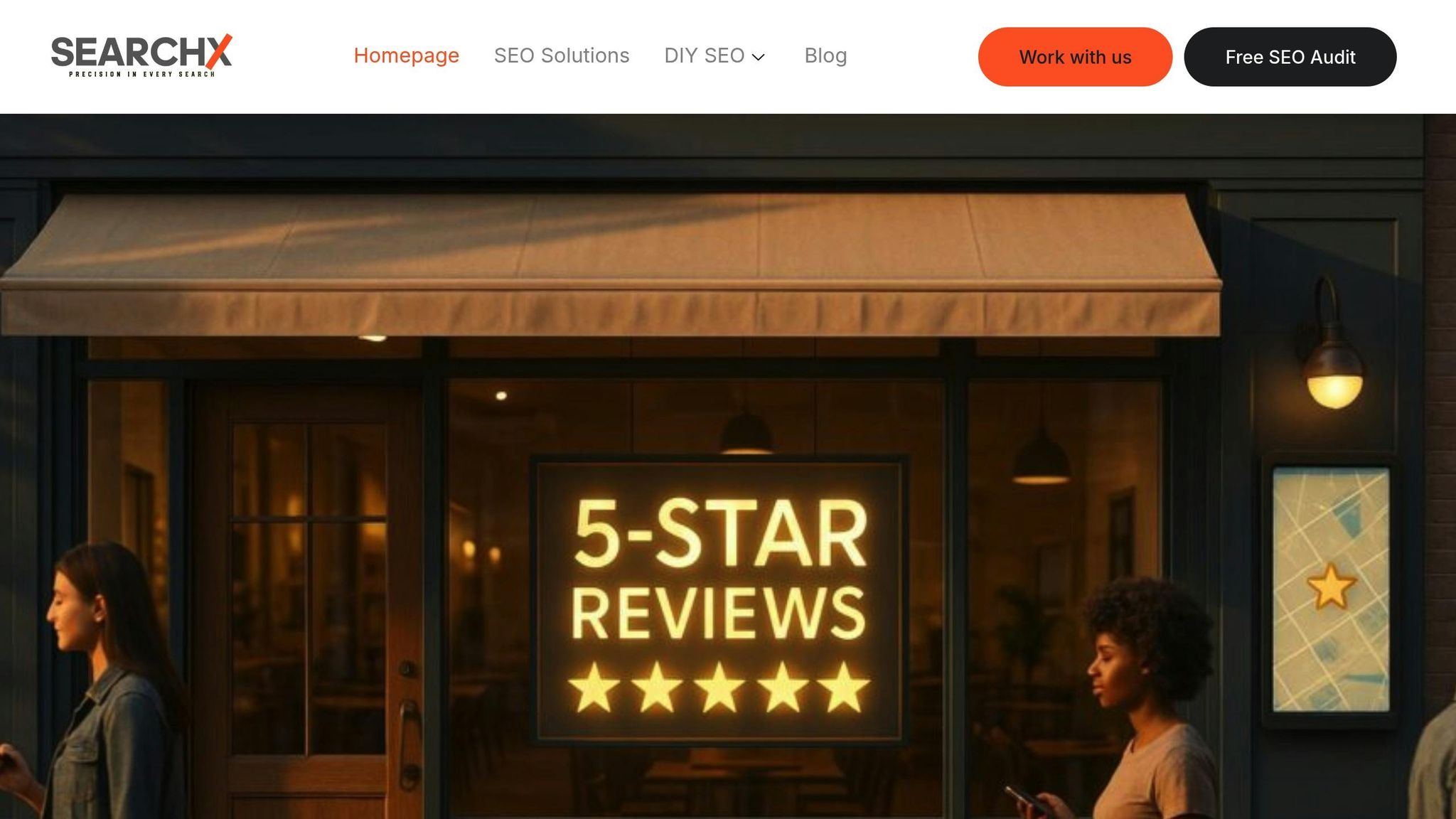In 2025, Austin’s booming growth and tech-driven population have made local SEO more important than ever. To stand out in this competitive market, businesses must go beyond basic SEO. Here’s a quick overview of what you need to know:
- Why Local SEO Matters: With Austin’s diverse neighborhoods and tech-savvy residents, businesses need to rank for hyper-local searches like “coffee shops in Mueller” or “plumbers near Lake Travis.” Voice search and mobile-first indexing are also shaping search behaviors.
- Key Strategies:
- Local Business Schema Markup: Use structured data to enhance visibility in search results and voice search.
- Mobile-First Optimization: Ensure fast-loading, mobile-friendly pages with accurate business information.
- Austin-Specific Keywords: Target neighborhood-focused and event-driven keywords, such as “SXSW catering” or “Landscaping in Westlake Hills.”
- NAP Consistency: Keep your Name, Address, and Phone number consistent across platforms.
- Content for Local Intent: Create Austin-focused content that answers specific questions like “Best BBQ near Zilker Park.”
- Performance Tracking: Monitor Google Business Profile insights, local pack rankings, and conversion metrics to measure success.
Austin’s market is driven by local searches, mobile users, and event-driven trends. These advanced strategies help businesses stay visible and competitive in this dynamic environment.
Setting Up Local Business Schema Markup
Schema markup plays a vital role in helping Google understand your Austin business details, including your services and the areas you serve. In a competitive city like Austin, structured data becomes a key tool for standing out. As search engines increasingly rely on AI to deliver precise local results, implementing schema markup correctly can significantly boost your visibility, especially in mobile-first and keyword-driven strategies.
What Is Local Business Schema and Why It Matters
Local business schema is a type of structured data added to your website that gives search engines detailed information about your business. Think of it as a digital business card specifically designed for search engines. This code provides essential details like your business name, address, phone number, operating hours, services, and the neighborhoods you serve in Austin.
Using schema markup effectively can greatly improve your search visibility. For instance, it enables rich snippets in search results, which display extra information such as star ratings, business hours, and contact details. These enhanced listings make your business stand out and are more likely to attract clicks compared to competitors without schema markup.
It also helps your business appear in Google’s Knowledge Graph. For Austin businesses, this means that when someone searches for your company or related services, Google can display a detailed panel with your location, reviews, photos, and contact information – all in one place.
Additionally, schema markup is crucial for voice search optimization. With more Austin residents using voice assistants to find local services, having structured data makes it easier for these systems to recommend your business for queries like "best coffee shop in the Domain" or "plumbers near me in South Austin."
How to Add Schema Markup for Austin Businesses
The easiest way to implement schema is by using JSON-LD (JavaScript Object Notation for Linked Data), which is Google’s preferred format. This code is added to the <head> section of your website’s HTML or through your content management system. Start with the basic LocalBusiness schema type and customize it to match your business category.
Accuracy is critical. Ensure your NAP information (Name, Address, Phone) is consistent with your Google Business Profile. Any discrepancies can confuse search engines and harm your rankings.
If you serve multiple neighborhoods in Austin, use the areaServed property to specify these areas. Instead of a broad "Austin" designation, list specific neighborhoods like Westlake Hills, Bee Cave, or Lakeway. This approach helps you rank for hyper-local searches, which are common in Austin’s diverse neighborhoods.
For businesses with seasonal or event-related changes, like during South by Southwest (SXSW) or Austin City Limits Music Festival, include the specialOpeningHoursSpecification property. This ensures search engines display accurate hours during these peak periods.
If your website features customer reviews, consider adding review aggregation schema. This can make your star ratings visible in search results, providing valuable social proof in Austin’s competitive market, where reviews often influence consumer decisions.
Schema Validation and Optimization Best Practices
Once your schema markup is added, validate it using Google’s Rich Results Test. This free tool identifies any errors or missing elements that could prevent your rich snippets from appearing. Make it a habit to run this test after every update to your schema or website.
For a deeper validation, use the Schema Markup Validator. It checks your code against the full Schema.org vocabulary, ensuring compatibility with all search engines and structured data platforms.
Track your schema performance through Google Search Console. The "Enhancements" section highlights pages with valid schema markup and flags any errors. Pay special attention to the "Local Business" report to monitor your local business schema implementation.
Keep your schema markup in sync with your Google Business Profile and other online listings. If you update your hours, services, or contact details, reflect these changes in your schema markup immediately. Inconsistencies can confuse search engines and hurt your rankings.
Review your schema quarterly to ensure it stays accurate as your business evolves. Whether you’re adding new services, modifying hours, or expanding to new neighborhoods, regular updates to your structured data ensure optimal performance in Austin’s dynamic market.
For complex businesses with multiple locations or diverse services, consider using nested schema. This allows you to specify unique details for each location or service type, such as different hours or service areas. Regular audits of your schema markup not only maintain accuracy but also lay the groundwork for stronger local SEO strategies.
Mobile-First Optimization for Local Searches
In Austin, where the tech-savvy crowd heavily relies on mobile devices for local searches, businesses need to prioritize mobile-first optimization. If your mobile site doesn’t perform well, you risk losing potential customers who are searching for services in the area.
How Mobile-First Indexing Impacts Local SEO
With Google’s mobile-first indexing, your mobile site – not your desktop version – is the primary factor for indexing and ranking. For local businesses in Austin, this shift means rethinking SEO strategies to stay visible in searches that are specific to neighborhoods or communities.
Page speed plays a big role here. If your mobile site loads slowly, it can hurt your rankings and discourage users from staying on your page. On the flip side, a fast-loading mobile site can improve engagement and visibility in local searches.
To stay competitive, ensure that your mobile site includes all the key details featured on your desktop version, such as your business name, service areas, and Austin-focused content. Google relies on this information to understand your business and rank it appropriately in local search results.
Mobile search features, like local business panels and map results, are designed to highlight essential business details. By optimizing your mobile site for these features, you increase your chances of appearing in these prominent spots. Beyond speed, creating well-optimized landing pages tailored to mobile users can further improve engagement.
Building Austin-Specific Landing Pages
Dedicated landing pages for different Austin neighborhoods are a great way to attract hyper-local search traffic. These pages should provide concise, mobile-friendly content and include clear calls-to-action that are easy to engage with on smaller screens.
For instance, if you’re a landscaping company, you could create pages like "Landscaping Services in Westlake Hills" or "Yard Care in Mueller", with content that speaks to the specific needs of those areas. Mentioning local landmarks or well-known streets, such as "serving businesses along South Lamar Boulevard" or "residential services from Barton Creek to Lake Travis", helps establish your geographic relevance.
Adding an interactive Google Map to these pages can make it easy for users to find directions or locate your business. You can also tap into Austin’s event-driven culture by updating your pages with details about major events like SXSW, Austin City Limits, or Formula 1. These updates can help you capture the increased search traffic that comes with these events.
Lastly, include clickable local phone numbers (e.g., 512 or 737 area codes) to make it easy for users to call you directly. This small detail can go a long way in building trust with local customers.
Maintaining NAP Consistency Across Platforms
After optimizing your mobile site and creating Austin-specific landing pages, it’s crucial to ensure your business information is consistent everywhere. NAP consistency – your Name, Address, and Phone number – matters a lot for local SEO, especially with mobile-first indexing. Search engines rely on this information to verify your business and determine its local ranking.
Audit your NAP details across your website, Google Business Profile, Yelp, Facebook, and directories like the Austin Chamber of Commerce or Austin Business Journal. Even minor inconsistencies, like "Street" versus "St." or missing suite numbers, can confuse search engines and hurt your rankings.
For mobile users, accurate contact information is non-negotiable. If someone finds your business via a mobile search, they’re likely looking to call, visit, or get directions immediately. Inconsistent details can frustrate users and lead to missed opportunities.
To stay on top of this, use tracking tools to monitor your NAP consistency. If you make any changes – like updating your address or phone number – update all platforms simultaneously to avoid temporary discrepancies. Also, test how your NAP details appear on mobile devices. Some directories may cut off longer business names or addresses on smaller screens, so make sure the most important information is always visible.
Keyword Research and Content Strategies for Austin
Austin is a city buzzing with tech innovation, live music, and rapid growth, which creates unique local search trends. With 78% of local mobile searches leading to a purchase, nailing your keyword strategy can directly impact your business’s success.
Finding Austin-Specific Keywords with Advanced Tools
To tap into Austin’s diverse search behaviors, businesses need to go beyond generic local keywords. The goal is to uncover long-tail keywords that reflect how locals search for services in their specific neighborhoods and communities.
Start by analyzing geographic modifiers that go beyond just "Austin." For example, neighborhoods like South Austin, East Austin, Cedar Park, and Round Rock have their own search patterns. A plumbing service could target terms like "emergency plumber Westlake Hills" or "drain cleaning Mueller district" to zero in on specific areas.
Seasonal and event-driven keywords also play a big role. During SXSW, searches spike for phrases like "catering near convention center Austin" or "parking downtown Austin in March." Similarly, Formula 1 events spark interest in terms like "hotels Circuit of the Americas" or "shuttle service F1 Austin."
Local landmarks and cultural references can further refine your keyword strategy. A fitness studio might focus on "yoga classes near Zilker Park", while a restaurant could target "brunch spots on Rainey Street" or "food trucks in East Austin." These terms help businesses connect with specific local audiences.
Mobile keyword research is especially critical in Austin, where most local searches happen on mobile devices. Voice searches, in particular, tend to be longer and more conversational. For instance, instead of typing "Austin BBQ restaurants", someone might ask, "Where can I get BBQ near me in Austin right now?" Tailoring your strategy to these natural speech patterns can give you an edge.
Use tools that highlight search trends specific to the Austin metro area and pay attention to seasonal patterns. For example, a boat rental company should optimize for "Lake Travis boat rental" well before the summer season kicks off.
Creating Content for Local Intent and Voice Search
Austin’s tech-savvy residents are big on voice search, so creating conversational, locally relevant content is key to boosting your local SEO.
Voice searches often start with questions like "where", "when", "how", or "what." Your content should directly answer these queries. For example, instead of just listing your services, include sections like "What’s the best time to schedule AC repair in Austin?" or "How much does tree removal cost in Austin?" This approach not only aligns with voice search patterns but also positions your business as a helpful local expert.
Focus on local intent content that addresses Austin-specific needs. A landscaping company might write about "drought-resistant plants for Austin yards" or "preparing your lawn for Austin heat waves." This type of content shows that you understand the unique challenges faced by Austin residents.
Incorporate Austin’s character naturally into your content by referencing local events, weather, and community concerns. For example, a security company could write about "home security during SXSW" or "protecting your business during Austin flooding season." This strategy not only engages locals but also helps build authority in the community, which search engines reward.
To optimize for voice searches, structure your content with natural language and FAQ-style sections. Instead of generic headers like "Austin HVAC Services", try something like "Who provides reliable air conditioning repair in Austin?" This mirrors how people speak when using voice commands and makes your content more relatable.
Finally, weave Austin-specific keywords naturally into your content. Avoid keyword stuffing and focus on creating genuinely useful information that aligns with seasonal trends and local search intent.
Adding Austin Trends to Your Content Strategy
Austin’s vibrant calendar of events offers predictable opportunities to create timely, engaging content. Planning your content around these seasonal trends can help you capture search traffic when it peaks.
Music and festival-related content is a major draw. For instance, a transportation company could publish a guide like "Getting to ACL Festival: Parking and Shuttle Guide" ahead of the event. Similarly, hotels might create content such as "Where to Stay During SXSW: Neighborhood Guide."
Seasonal trends also provide consistent opportunities. In the summer, focus on lake-related activities with topics like "Best Swimming Spots on Lake Austin" or "Boat Rental Tips for Beginners." Fall could bring content centered around UT football, while spring might highlight outdoor activities and festivals.
sbb-itb-880d5b6
Tracking and Measuring Local SEO Performance in Austin
Austin’s vibrant and competitive market makes it essential to track the right local SEO metrics to refine your strategy and ensure a strong return on investment (ROI).
Key Metrics to Monitor for Local SEO Success
When evaluating your local SEO efforts in Austin, focus on these critical metrics:
- Local pack rankings: These are the top three businesses displayed in the map section of search results for local queries. Keeping an eye on your rankings in key Austin neighborhoods can help improve visibility and drive more clicks.
- Google Business Profile insights: This tool reveals how customers are discovering and engaging with your business. Track data like total views, search queries, and customer actions such as website clicks, driving directions, and phone calls. Discovery searches (indicating new customer reach) and direct searches (reflecting brand recognition) are especially important.
- Austin-specific organic traffic: Monitor traffic generated by localized keywords tied to neighborhoods, landmarks, or local culture. For example, a restaurant might track searches like "best tacos near Barton Springs" or "happy hour on South Congress" to gauge interest from local audiences.
- Conversion tracking: Tools like Google Analytics can help you set up goals to track actions like form submissions, phone calls, and online bookings tied to local search traffic. This provides a clear picture of how local SEO contributes to business outcomes.
- Review metrics: Reviews directly influence local search rankings. Pay attention to the volume, frequency, and average rating of reviews, as well as customer comments. Austin customers may highlight factors like parking convenience or proximity to popular attractions, offering insight into what matters most.
By focusing on these metrics, you can extract actionable insights to guide your local SEO strategy.
Best Tools for Local SEO Performance Tracking
Several tools can simplify the process of tracking and analyzing your local SEO performance in Austin:
- Google Analytics 4: This tool allows you to segment traffic by location, making it easy to analyze how Austin-based visitors interact with your site. You can also connect local search traffic to revenue through custom reports.
- Google Search Console: Use this to identify Austin-specific search queries driving traffic to your site. Performance reports provide data on impressions, clicks, and average positions for local keywords, while geographic insights pinpoint areas of Austin generating the most interest.
- SearchX: Designed for local SEO, this platform integrates data from multiple sources to offer a complete view of your performance in Austin’s market.
Connecting Growth to Local SEO Efforts
Tracking metrics is only half the battle – connecting them to business growth ensures your strategy delivers results.
- Attribution modeling and revenue tracking: Tools like multi-channel funnels in Google Analytics help you understand how customers interact with various touchpoints before converting. Assign monetary values to these actions to identify the most profitable Austin keywords and content.
- Seasonal trends and event tracking: Austin hosts major events like SXSW, ACL Festival, and UT football games. Aligning your local SEO efforts with these events can uncover opportunities for targeted campaigns and optimizations.
- Customer lifetime value (CLV): Acquiring customers through local search often leads to higher retention and referrals. Tracking CLV by acquisition channel highlights the long-term benefits of local SEO.
- Call tracking integration: Dynamic number insertion assigns unique phone numbers to specific campaigns or landing pages. This helps you identify which Austin neighborhoods or services are driving the most leads.
For a deeper dive into measuring the ROI of organic traffic growth, check out this guide. Prioritize metrics tied to business outcomes rather than vanity numbers to demonstrate the true value of your efforts.
Lastly, competitive benchmarking is a powerful way to assess your position in Austin’s local market. Comparing your visibility with competitors can reveal opportunities to capture untapped market share in specific neighborhoods.
Conclusion: Scaling SEO Success in Austin’s Market with SearchX

Austin’s dynamic market demands cutting-edge local SEO strategies that turn competitive insights into real growth. The tactics outlined here provide a clear path for businesses aiming to claim a bigger slice of Austin’s market.
Key Takeaways for Excelling in Austin’s Local SEO
- Local business schema markup ensures your business details are accurately presented across Austin’s neighborhoods, improving visibility in local pack results and rich snippets.
- Mobile-first optimization is non-negotiable. Fast-loading, Austin-focused landing pages with precise NAP (Name, Address, Phone) details can give you a decisive edge.
- Advanced keyword research uncovers unique local search trends and high-intent traffic, especially during events like South by Southwest or University of Texas gatherings.
- Performance tracking links your SEO efforts to tangible outcomes by monitoring local pack rankings, Google Business Profile data, and organic traffic specific to Austin.
These strategies serve as the foundation for steady growth, further enhanced by SearchX’s tailored services.
How SearchX Empowers Austin Businesses
SearchX takes these strategies to the next level with solutions designed specifically for Austin’s market.
- Growth Plan ($6,000/month): This plan includes targeted content creation, SEO audits, and competitor analysis, enabling businesses to target multiple neighborhoods and capitalize on seasonal opportunities.
- Enterprise Plan (starting at $12,000/month): With expanded content, comprehensive on-site and off-site SEO management, and AI-powered visibility tracking, this plan ensures businesses stay ahead in Austin’s evolving search landscape.
SearchX’s specialized local SEO services include keyword research tailored to Austin’s unique opportunities and technical SEO audits that optimize websites for mobile-first indexing. This holistic approach ensures businesses benefit from coordinated strategies rather than isolated efforts.
Additionally, their local listing management spans over 50 directories, ensuring consistent and accurate business information across Austin’s digital ecosystem. This is crucial for businesses targeting multiple neighborhoods or competing in highly localized markets.
FAQs
How does using local business schema markup boost visibility for businesses in Austin?
Local business schema markup can help your Austin-based business stand out by providing search engines with structured details like your business name, address, phone number, and operating hours. This extra layer of information makes it easier for search engines to display your business in rich search results and local listings, boosting your visibility.
When you implement schema markup, search engines gain a clearer understanding of your business. This can lead to better indexing and potentially higher rankings in local search results. The result? More organic traffic to your site and stronger connections with your target audience in Austin’s competitive market.
How can I ensure my business’s Name, Address, and Phone Number (NAP) are consistent across platforms for better local SEO?
Maintaining NAP consistency – your business’s Name, Address, and Phone Number – is key to improving local SEO. Make sure these details are listed exactly the same across your website, social media profiles, and online directories. Even small inconsistencies, like abbreviations or formatting differences, can create confusion for search engines and potential customers.
To make this easier, you can use tools that automatically sync and update your NAP information across various platforms. Another helpful step is adding local business schema markup to your website. This markup allows search engines to verify your NAP details, which can improve your local search rankings. Regularly auditing your listings is also a smart way to catch errors and maintain trust with both search engines and your audience.
How can I use Austin-specific keywords to boost my local SEO in 2025?
To improve your local SEO with Austin-focused keywords, make sure to naturally weave geo-specific phrases like "Austin web design" or "best coffee shops in Austin" into your site’s content, titles, and meta descriptions. Tools for advanced keyword research can help you uncover high-traffic, location-specific terms related to your field, such as "Austin event planners" or "IT services in Austin."
You can also increase relevance by referencing local landmarks, neighborhoods, or cultural touchpoints. Mentioning spots like South Congress or Zilker Park not only resonates with Austin users but also boosts your visibility in local searches. Just remember to use these keywords in a way that feels organic – readability matters, and keyword stuffing can do more harm than good.




